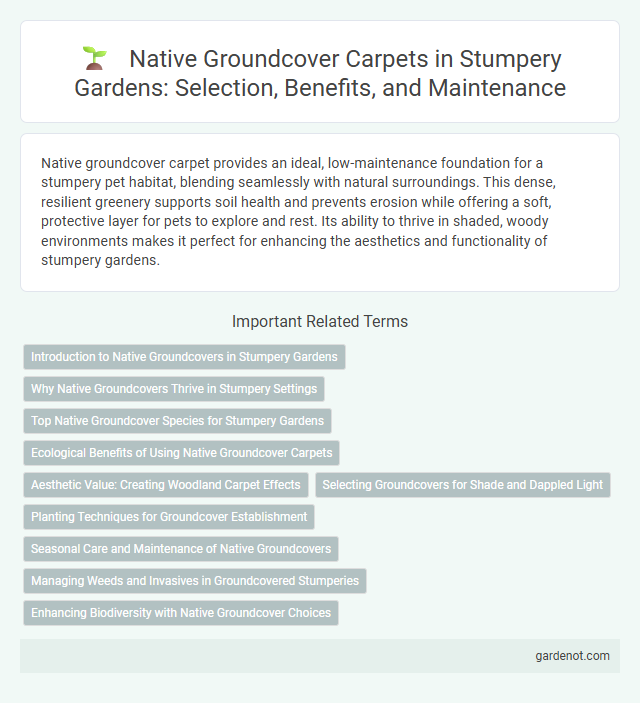Native groundcover carpet provides an ideal, low-maintenance foundation for a stumpery pet habitat, blending seamlessly with natural surroundings. This dense, resilient greenery supports soil health and prevents erosion while offering a soft, protective layer for pets to explore and rest. Its ability to thrive in shaded, woody environments makes it perfect for enhancing the aesthetics and functionality of stumpery gardens.
Introduction to Native Groundcovers in Stumpery Gardens
Native groundcovers in stumpery gardens create a lush, natural carpet that thrives in shaded, woodland environments. Species such as wild ginger (Asarum spp.), foamflower (Tiarella cordifolia), and creeping phlox (Phlox stolonifera) are ideal for stabilizing soil and enhancing biodiversity. These groundcovers provide essential habitat for native fauna while complementing the textured wood and stone elements of the stumpery.
Why Native Groundcovers Thrive in Stumpery Settings
Native groundcovers thrive in stumpery settings due to their natural adaptation to shaded, moist conditions created by decaying wood and dense plant layers. These groundcovers, such as ferns, mosses, and wildflowers, benefit from the rich organic matter and stable microclimate that stumperies provide, promoting vigorous growth and resilience. Their symbiotic relationship with native fungi and insects further enhances soil health and biodiversity, ensuring sustained vitality in these curated woodland displays.
Top Native Groundcover Species for Stumpery Gardens
Top native groundcover species for stumpery gardens include Ajuga reptans, which provides dense, low-growing foliage and attractive blue flowers, and Asarum canadense, known for its heart-shaped leaves and shade tolerance. Other effective options are Pachysandra procumbens, valued for its evergreen leaves and adaptability to woodland settings, and Mitchella repens, offering vibrant red berries and a carpet-forming habit. These species contribute to moisture retention, soil stability, and enhanced biodiversity in stumpery environments.
Ecological Benefits of Using Native Groundcover Carpets
Native groundcover carpets support biodiversity by providing essential habitat and food sources for local wildlife, including pollinators and soil organisms. Their deep root systems enhance soil health by preventing erosion, improving water retention, and promoting nutrient cycling. Using native groundcovers in a stumpery setting reduces the need for chemical fertilizers and pesticides, fostering a sustainable and resilient ecosystem.
Aesthetic Value: Creating Woodland Carpet Effects
Native groundcover plants such as wild ginger, moss, and foamflower establish lush, textured layers that mimic the natural woodland floor, enhancing the stumpery's organic appeal. Their intertwined growth forms a dense, living carpet that enriches visual depth and contrasts with aged wood and ferns. This combination transforms the stumpery into a vibrant, immersive woodland scene that highlights biodiversity and seasonal changes.
Selecting Groundcovers for Shade and Dappled Light
Select native groundcovers like wild ginger (Asarum canadense), foamflower (Tiarella cordifolia), and creeping phlox (Phlox stolonifera) for shaded or dappled light areas in a stumpery. These species thrive in low-light conditions, providing dense, lush carpets that suppress weeds and retain soil moisture. Their adaptability to woodland environments supports biodiversity while enhancing the natural aesthetic of a stumpery garden.
Planting Techniques for Groundcover Establishment
Effective planting techniques for native groundcover carpet involve selecting shade-tolerant species like wild ginger or creeping phlox that thrive under tree canopies. Preparing the soil by loosening the top layer and incorporating organic mulch enhances moisture retention and root establishment. Strategic spacing of plugs or cuttings promotes dense coverage, prevents erosion, and encourages rapid colonization for a sustainable living carpet.
Seasonal Care and Maintenance of Native Groundcovers
Native groundcover carpets require seasonal care to thrive, including regular mulching in spring to enhance moisture retention and suppress weeds. Autumn demands thorough leaf removal and light pruning to maintain plant health and encourage vigorous growth. Winter protection through mulching or frost cloths helps prevent damage from frost and extreme cold, ensuring the groundcover remains resilient year-round.
Managing Weeds and Invasives in Groundcovered Stumperies
Managing weeds and invasives in native groundcover carpets within stumperies involves regular monitoring and targeted removal to prevent competition and preserve biodiversity. Utilizing mulch and selective planting of robust native species enhances groundcover resilience against invasive plants. Maintaining soil health through minimal disturbance and organic amendments supports the stability and growth of native groundcover ecosystems in stumpery environments.
Enhancing Biodiversity with Native Groundcover Choices
Native groundcover carpets such as wild ginger, blueberry leaf, and foamflower play a crucial role in enhancing biodiversity within a stumpery by providing habitat and food sources for local insects and wildlife. These native species improve soil health through natural nutrient cycling and moisture retention, supporting a balanced and resilient ecosystem. Incorporating diverse native groundcovers promotes ecological stability and enriches the overall plant community, making the stumpery a thriving microhabitat.
Native groundcover carpet Infographic

 gardenot.com
gardenot.com